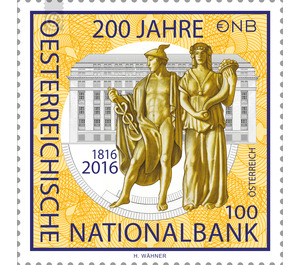200 years - Austria / II. Republic of Austria 2016 - 100 Euro Cent
Theme: Economy & Industry
| Country | Austria / II. Republic of Austria |
| Issue Date | 2016 |
| Face Value | 100.00 |
| Edition Issued | 170,000 |
| Printing Type | Offset printing, gold foil, blind embossing |
| Stamp Type | Commemorative |
| Item Type | Stamp |
| Chronological Issue Number | 2580 |
| Chronological Chapter | OOS-OE2 |
| SID | 877773 |
| In 72 Wishlists | |
It is 200 years since the "Privileged Austrian National Bank" was founded in 2016 as a central bank. Austrian Post honors this anniversary with its own special stamp. The main concern of those days was to rearrange the money system in Austria, which had been shattered after the Napoleonic Wars. Even before, there had been experiments by the Habsburgs to commission an institute to issue paper money. However, the National Bank was given a particularly privileged position: it had the sole right to issue notes. This "first bank privilege" got the institute in 1817, the constitution of the definitive bank administration took place in 1818; the uniform supply of money and credit should be ensured. From its inception to today, it was the task of the Austrian National Bank to stabilize the currency - and this independently of the government, which was a right to defend constantly, especially in the early days. In 1878, the Austrian became the Austro-Hungarian National Bank, which ran branches in all parts of the Danube Monarchy. Her duties included the introduction of the crown in 1892, which gradually replaced the guilder. - With the beginning of the euro as book money in 1999, although the National Bank's monetary and monetary authority was transferred to the European Central Bank, the OeNB is an integral part of the European System of Central Banks and operates in terms of human, financial and institutional independence. The main task of the OeNB today is the operational implementation of monetary policy in Austria. It contributes to the stability of prices and the money and credit markets, manages the currency reserves, handles the euro payments and provides safe cash for the Austrian population.


